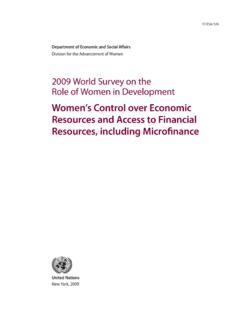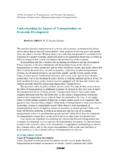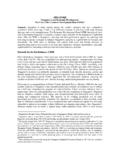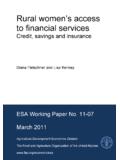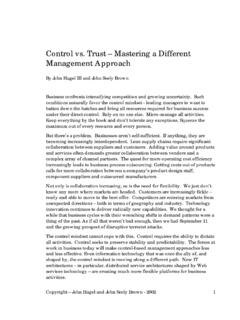Transcription of Empowering rural women through social protection
1 rural TRANSFORMATIONS - Technical Papers Series #2 social protection Empowering rural women through social protection rural TRANSFORMATIONS - Technical Papers Series #2 social protection Empowering rural women through social protection Ana Paula de la O Campos social protection Division (ESP). Food and Agriculture Organization of the United Nations FOOD AND AGRICULTURE ORGANIZATION OF THE UNITED NATIONS. ROME, 2015. Cover photo: FAO/Amos Gumulira The designations employed and the presentation of material in this information product do not imply the expression of any opinion whatsoever on the part of the Food and Agriculture Organization of the United Nations (FAO) concerning the legal or development status of any country, territory, city or area or of its authorities, or concerning the delimitation of its frontiers or boundaries.
2 The mention of specific companies or products of manufacturers, whether or not these have been patented, does not imply that these have been endorsed or recommended by FAO in preference to others of a similar nature that are not mentioned. The views expressed in this information product are those of the author(s) and do not necessarily reflect the views or policies of FAO. FAO, 2015. FAO encourages the use, reproduction and dissemination of material in this information product. Except where otherwise indicated, material may be copied, downloaded and printed for private study, research and teaching purposes, or for use in non-commercial products or services, provided that appropriate acknowledgement of FAO as the source and copyright holder is given and that FAO's endorsement of users' views, products or services is not implied in any way.
3 All requests for translation and adaptation rights, and for resale and other commercial use rights should be made via or addressed to FAO information products are available on the FAO website ( ) and can be purchased through Contents ACKNOWLEDGMENTS V. ABSTRACT VII. INTRODUCTION 1. THE CONTRIBUTION OF social protection TO women 'S ECONOMIC EMPOWERMENT 2. LINKING women 'S ECONOMIC EMPOWERMENT WITH social protection 5. DOES social protection EMPOWER women ? 9. I. CASH TRANSFERS 10. Economic advancement 11. Power and agency 13. In conclusion 14. II. ASSET TRANSFERS (ALSO KNOWN AS ASSET PACKAGES) 15. Economic advancement 15.
4 Power and agency 16. In conclusion 17. III. SAFETY NET-ORIENTED PUBLIC WORKS PROGRAMMES 17. Economic advancement 17. Power and agency 19. In conclusion 19. IV. MICRO-INSURANCE MECHANISMS 19. Economic advancement 20. Power and agency 21. In conclusion 21. V. INPUT SUBSIDIES 21. Power and agency 21. SUMMARY OF THE IMPACTS ON women 'S EMPOWERMENT 23. PROMOTING women 'S EMPOWERMENT IN social protection 25. I. INTEGRATED social protection SYSTEMS FOR rural women 'S ECONOMIC EMPOWERMENT 26. II. ACHIEVING women 'S ECONOMIC EMPOWERMENT through GENDER-SENSITIVE DESIGN IN social protection . PROGRAMMES 28. MAKING social protection A CATALYST FOR women 'S ECONOMIC EMPOWERMENT 31.
5 SOURCES 33. Figures Figure 1. A framework for evaluating the contribution of social protection interventions towards rural women 's economic empower- ment 2. Figure 2. Linkages between rural women 's economic empowerment and the four functions of social protection 6. Figure 3. Integrated social protection systems that promote gender equality and rural women 's economic empowerment 27. Tables Table 1. Summary of the literature review: women 's empowerment and social protection schemes 9. Table 2. Review of the evidence: Does social protection empower women ? social protection schemes and their contribution to rural women 's economic empowerment 23.
6 Table 3. women as targets of social protection schemes: Different conceptions of women 's roles in poverty reduction 25. Table 4. Examples of gender-sensitive design in social protection programmes 29. Acknowledgments This paper was prepared as background research for FAO's forthcoming State of Food and Agriculture 2015 and to guide FAO in its work on social protection and women 's empowerment. The author is most grateful for the valuable feedback from numerous FAO colleagues: Rob Vos, Susan Kaaria, Vito Cistulli, Marco Knowles, Benjamin Davis, Libor Stloukal and Hajnalka Petrics. The author also wishes to thank Verdiana Biagioni for her invaluable input.
7 V Abstract Besides reducing poverty, social protection has great potential for promoting women 's economic empowerment and reducing gender inequalities. Nevertheless, the contribution of current social protection schemes to these development goals is still limited. When women are designated transfer recipients, social protection schemes can facilitate their access to resources and promote their role as decision-makers in the household; however, these outcomes do not happen automatically. For example, cash transfer schemes require complementary services to ensure that women cash recipients maintain control over their own incomes and decision- making capacity.
8 Asset transfer schemes need to take into account women 's capacities, needs and aspirations in terms of resources and skills development. Similarly, public works programmes need to improve women 's skills and promote employability after completion of the programme. The design of social protection schemes requires an integrated approach, linking with other livelihood programmes and social services, so that these can lead to sustainable poverty reduction. Finally, changing mind- sets and perceptions about women in social protection policies and programmes is needed, not only to protect women 's roles as mothers and care takers, but also to promote their economic empowerment.
9 Vii Introduction social protection creates an enabling A coordinated bundle of social protection policies environment for promoting the economic and programmes, namely those that increase empowerment of the poor. It is now widely women 's access to resources, enhance their skills, accepted that in addition to its safety net and increase their participation in the labour function, social protection also increases market and social networks (among others), not the income of poor households either by only fosters women 's economic empowerment guaranteeing a minimum income or employment, but also helps to more effectively and sustainably or via insurance or subsidies.
10 These benefits allow reduce rural poverty and vulnerability (Holmes poor households to invest in productive assets and Jones, 2013; Sabates-Wheeler and Devereux, and diversify their income-generating activities, 2007). This paper makes this case through a and also to invest in human capital towards review of evidence on the most widely-used achieving food security (Tirivayi, Knowles, and social protection schemes, assessing the extent of Davis, 2013; World Bank, 2014a). Furthermore, their current and potential impact on women 's when social protection schemes include cash economic empowerment and, when possible, the transfers or cash payments for work, and these programme design characteristics that lead to payments are delivered through banks or these impacts.










